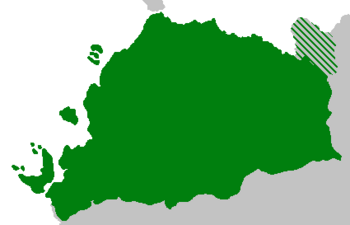Oscaunja: Difference between revisions
m (→Government) |
m (→Government) |
||
| Line 126: | Line 126: | ||
===Government=== | ===Government=== | ||
The government of the Kingdom of Oscaunja, as defined by the Constitution of 1919 and later reconfirmed in the amended Constitution of 1927, | The government of the Kingdom of Oscaunja, as defined by the Constitution of 1919 and later reconfirmed in the amended Constitution of 1927, | ||
consists of a hereditary Monarch, the''Rrai'', as executive, with the right to propose and veto laws, a final Court of Appeal,''O'Assedir'', which enforces Royal decrees, and the legislature, the Royal Council (''Concialle Rraile''), which is organized corporately | consists of a hereditary Monarch, the''Rrai'', as executive, with the right to propose and veto laws, a final Court of Appeal,''O'Assedir'', which enforces Royal decrees, and the legislature, the Royal Council (''Concialle Rraile''), which is organized corporately with members who are both hereditary and appointed. The head of the Concialle is the''Vocadir'' (Chief Advocate). | ||
Local government is carried out by officials who receive the non-hereditary noble title ''Sijore'', while provincial governors are entitled ''Barune''.The noble title ''Conde'' is non-political yet retains immense prestige and almost all ''Condi'' are members of the Concialle Rraile. The title ''Dujo'' is reserved for members of the royal family, while ''Prinje'' is used by the descendants of the original Hartmanni clans. | Local government is carried out by officials who receive the non-hereditary noble title ''Sijore'', while provincial governors are entitled ''Barune''.The noble title ''Conde'' is non-political yet retains immense prestige and almost all ''Condi'' are members of the Concialle Rraile. The title ''Dujo'' is reserved for members of the royal family, while ''Prinje'' is used by the descendants of the original Hartmanni clans. | ||
Revision as of 03:09, 20 August 2019
This article is incomplete because it is pending further input from participants, or it is a work-in-progress by one author. Please comment on this article's talk page to share your input, comments and questions. Note: To contribute to this article, you may need to seek help from the author(s) of this page. |
Kingdom of Oscaunja Rraigno do Oscaunja | |
|---|---|
| Motto: Paies do Juorno (Country of Day) | |
| Anthem: Fronni d'Alia "Daughter of Alia" | |
 | |
| Capital | Kastomarre |
| Largest city | Kassano |
| Official languages | Linj'Arrendino |
| Recognized languages | Linj' Imazinga |
| Ethnic groups | Arrendini- 40.5% Imazzingi- 28.25% Rriguani- 21.75% Aulerriano- 6.5% Suddani 2.9% Other 0.1% |
| Demonym(s) | Oscaundano |
| Government | Constitutional Monarchy |
• Rrai | Reney IV Raissuolli |
• Vocadir | Gian di Verdecoye |
| History | |
• Three Kingdom Period | 653-1043 AD |
• Unification of Oscaunja | 1044 AD |
• Respoblija do Oscaunja | 1791-1792 AD |
• Kingdom of Oscaunja | 1792-1858 AD |
• Republique de Civivaté et Allié | 1858-1904 AD (annexed by the Auvernia) |
• Kingdom Restored | 1919 AD |
• Independence Regained | 1927 AD |
| Population | |
• 1936 estimate | 11,000,000 |
| GDP (PPP) | estimate |
• Total | 14.8 Billion Dollars |
| Currency | Oscaundano Duocado |
| Driving side | right |
The Kingdom of Oscaunja (Arrendino: Rraigno do Oscaunja; Alpanian: Regnum Auschonia), is a constitutional kingdom on the Northwestern coast of Nymera in the world of Verthandi. Founded in 1044 A.D. by Guillamo I the Unifier, Oscaunja remained an independent power for most of its history, until its annexation by the Auvernian Federation in 1904. Independence was regained following the deposition of Rrai Reney III and a short but bloody civil war in 1927.
Etymology
History
Three Kingdoms Period: 653-1044 A.D.
Unification: 1044 A.D.
Interregnum
Second Interregnum and the Hundred Year War: 1315-1415
The Three Ferrannos
House of Kastomarre-Beyprato
Respoblija do Oscaunja: 1791-1792
House of Raissuolli-Beyprato
Republique de Civivaté et Allié
Annexation and the Civil War
Restoration of the Monarchy
Independence War and Present Day
Geography
Politics
Government
The government of the Kingdom of Oscaunja, as defined by the Constitution of 1919 and later reconfirmed in the amended Constitution of 1927, consists of a hereditary Monarch, theRrai, as executive, with the right to propose and veto laws, a final Court of Appeal,O'Assedir, which enforces Royal decrees, and the legislature, the Royal Council (Concialle Rraile), which is organized corporately with members who are both hereditary and appointed. The head of the Concialle is theVocadir (Chief Advocate).
Local government is carried out by officials who receive the non-hereditary noble title Sijore, while provincial governors are entitled Barune.The noble title Conde is non-political yet retains immense prestige and almost all Condi are members of the Concialle Rraile. The title Dujo is reserved for members of the royal family, while Prinje is used by the descendants of the original Hartmanni clans.
The Concialle Rraile is broadly controlled by several factions, most notably the Leggemandi (Legitimists), the Pardo Respoblijano Nazionali (National Commonwealth Party), and the Lianzia Merkandi (Merchants Alliance).


